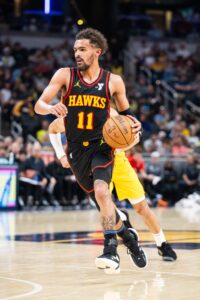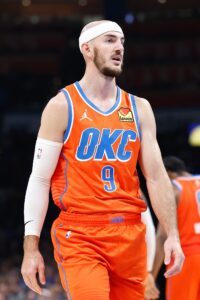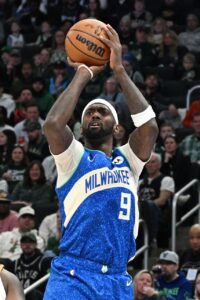NBA teams can become hard-capped during a given league year if they use specific cap exceptions or make certain transactions, but the league doesn’t have a hard cap in place for all its teams.
However, in addition to its soft cap, the league does have a luxury tax threshold, which serves to discourage excessive spending. When a team’s total salary is over that line at season’s end, the NBA charges a tax for every surplus dollar the club spends.
The luxury tax line is set each season at 121.5% of the salary cap threshold, rounded to the nearest thousand. In 2024/25, the league’s salary cap is set at $140,588,000, so the luxury tax threshold is $170,814,000. That means any team whose total ’24/25 salary exceeds $170,814,000 on the last day of the regular season is subject to a tax bill.
The NBA’s luxury tax system is set up so that the penalties become more punitive the further teams go beyond the tax line. Teams who are in the first tax bracket will pay a significantly less significant tax rate per dollar than teams operating in the third or fourth bracket (or beyond).
In 2023/24, the amount of each tax bracket was $5MM, which meant a team faced an increased tax rate once its total salary surpassed $5MM over the tax, $10MM over the tax, $15MM over the tax, and so on.
In 2024/25 and in subsequent seasons, the size of those tax brackets will increase at the same rate as the salary cap. For example, since the cap rose by about 3.36% from ’23/24 to ’24/25, the size of each tax bracket increased by 3.36% too, from $5MM to $5,168,000.
Here’s what the luxury penalties will look like in 2024/25:
Tax bracket
|
Amount above tax line
|
Tax rate (per $)
|
Maximum penalty
|
| 1 |
$1 – $5,168,000 |
$1.50 |
$7,752,000 |
| 2 |
$5,168,001 – $10,336,000 |
$1.75 |
$9,044,000 |
| 3 |
$10,336,001 – $15,504,000 |
$2.50 |
$12,920,000 |
| 4 |
$15,504,001 – $20,672,000 |
$3.25 |
$16,796,000 |
For each additional $5,168,000 above the tax line beyond $25,840,000 a team operates, its tax rates increase by $0.50 per dollar of team salary. So, the penalty is $3.75 per dollar between $20,672,001 and $25,840,000, $4.25 per dollar between $25,840,001 and $31,008,000, and so on.
Here’s a practical example of how the tax penalties work. The Nuggets currently have a team salary of $182,574,315, which is above this season’s tax line by $11,760,315, putting them in the third tax bracket. Denver’s total salary will likely move up or down before the season is over, but the team’s current projected tax bill is $20,356,788. That’s based on a penalty of $7,752,000 from the first tax bracket, $9,044,000 from the second, and $3,560,788 from the third (a penalty of $2.50 per dollar on $1,424,315).
The rates listed above apply to most taxpayers, including 10 of the 14 teams currently in the tax for 2024/25: the Nuggets, Suns, Timberwolves, Celtics, Knicks, Heat, Sixers, Mavericks, Pelicans, and Cavaliers. However, a team can become subject to a more punitive “repeater” penalty if it paid the tax in at least three of the previous four seasons.
This scenario currently applies to four teams — the Warriors, Clippers, Bucks, and Lakers paid the tax at least three times from 2021 to 2024, which means they’ll be repeat offenders this season.
Here are the penalties that apply to repeat taxpayers in 2024/25:
Tax bracket
|
Amount above tax line
|
Tax rate (per $)
|
Maximum penalty
|
| 1 |
$1 – $5,168,000 |
$2.50 |
$12,920,000 |
| 2 |
$5,168,001 – $10,336,000 |
$2.75 |
$14,212,000 |
| 3 |
$10,336,001 – $15,504,000 |
$3.50 |
$18,088,000 |
| 4 |
$15,504,001 – $20,672,000 |
$4.25 |
$21,964,000 |
As is the case with the standard penalties, the tax rate continues to increase by $0.50 per tax bracket, so a repeater taxpayer in the fifth bracket would face a tax rate of $4.75 per dollar; that would increase to $5.25 per dollar in the sixth tax bracket, and so on.
The Clippers are currently carrying $173,279,116 in total salary, surpassing the tax line by $2,465,116. Because they’re charged $2.50 per dollar as a repeater taxpayer, their projected tax bill is $6,162,790 instead of the standard rate of $3,697,674.
The further into tax territory a team goes, the greater the difference between the repeater rate and the standard rate becomes. For instance, the Bucks’ projected tax bill at the moment is $74,837,699. If they weren’t subject to repeater penalties, it would be just $52,554,394.
The 2024/25 season is the last one in which the rates outlined above will apply. Beginning in 2025/26, the NBA is adjusting the tax rates to make them even more punitive for repeater taxpayers and heavy spenders. Conversely, the penalties for standard taxpayers who finish the season in one of the first two tax brackets will be lowered.
Here are the changes coming next season:
Tax bracket
|
Standard tax rate (per $)
|
Repeater tax rate (per $)
|
| 1 |
$1.00 |
$3.00 |
| 2 |
$1.25 |
$3.25 |
| 3 |
$3.50 |
$5.50 |
| 4 |
$4.75 |
$6.75 |
These rates will continue to increase by $0.50 per tax bracket beyond the fourth bracket.
The goal of these tweaks is to discourage teams from soaring way beyond the luxury tax line without making the tax line itself a major deterrent.
Since luxury tax penalties are calculated by determining a team’s total cap hits at the end of its season, a team that starts the year above the tax line could get under it before the end of the season by completing trades or buyouts. The Pelicans did just that in 2023/24, moving out of tax territory by salary-dumping Kira Lewis‘ expiring contract in January.
New Orleans is one of just two NBA teams that has never been a taxpayer (Charlotte is the other) and is operating only narrowly above the tax line this season, so it wouldn’t be a surprise to see the team make another mid-season deal to duck the tax.
It’s also worth noting that team salary for tax purposes is calculated slightly differently than it is for cap purposes. Here are a few of the adjustments made at season’s end before a team’s tax bill is calculated:
- Cap holds and exceptions are ignored.
- “Likely” bonuses that weren’t earned are removed from team salary; “unlikely” bonuses that were earned are added to team salary.
- Note: Bonuses based on playoff-related criteria can be removed or added to team salary after the regular season ends. In that scenario, a team’s tax bill is based on its salary at the end of the team’s season (ie. its playoff run), not the end of the regular season.
- If a player with a trade bonus is acquired after the final regular season game, that trade bonus is added to team salary.
- If a rookie or second-year player signed a minimum-salary free agent contract, the applicable minimum-salary cap charge for a two-year veteran is used in place of that player’s cap charge.
- Note: This “tax variance” rule only applies to free agents, not drafted players.
So let’s say that five teams finish the season owing a total of $75MM in taxes. Where does that money go? Currently, the NBA splits it 50/50 — half of it is used for “league purposes,” while the other half is distributed to non-taxpaying teams in equal shares. In our hypothetical scenario, the 25 non-taxpaying teams would receive $2MM apiece.
As cap expert Larry Coon explains in his CBA FAQ, “league purposes” essentially covers any purpose the NBA deems appropriate, including giving the money back to teams. In recent years, the NBA has used that money as a funding source for its revenue sharing program.
Coon also notes that the CBA technically allows up to 50% of tax money to be distributed to non-taxpaying teams, but there’s no obligation for that to happen — in other words, the NBA could decide to use 100% of the tax money for “league purposes.”
Note: This is a Hoops Rumors Glossary entry. Our glossary posts will explain specific rules relating to trades, free agency, or other aspects of the NBA’s Collective Bargaining Agreement. Larry Coon’s Salary Cap FAQ was used in the creation of this post.
Earlier versions of this post were published in previous years.

 The maximum starting salary a player can receive in a veteran extension is up to 140% of his current salary. A player on a more modest contract can receive a maximum starting salary worth up to 140% of the
The maximum starting salary a player can receive in a veteran extension is up to 140% of his current salary. A player on a more modest contract can receive a maximum starting salary worth up to 140% of the 